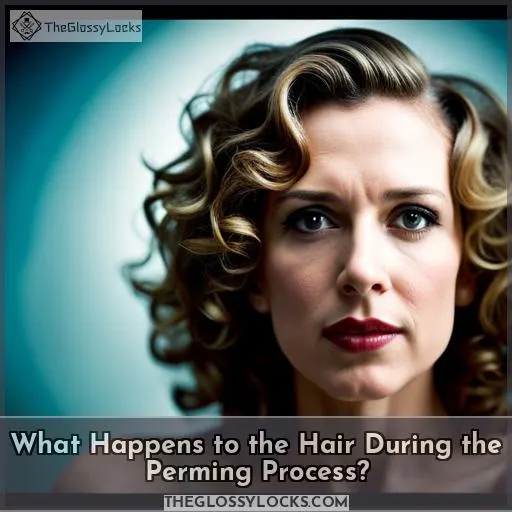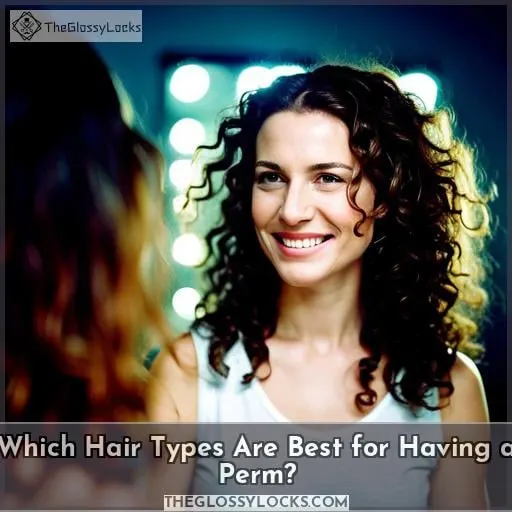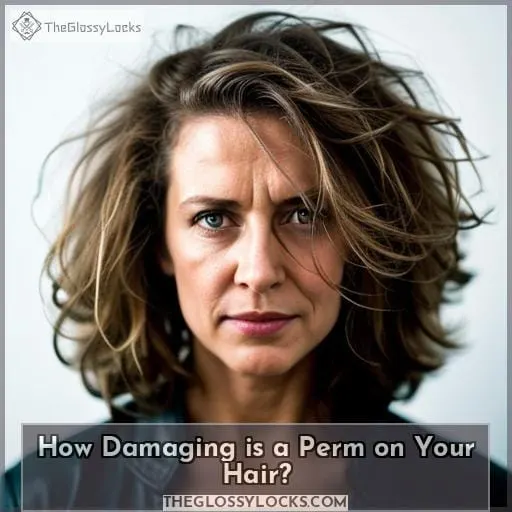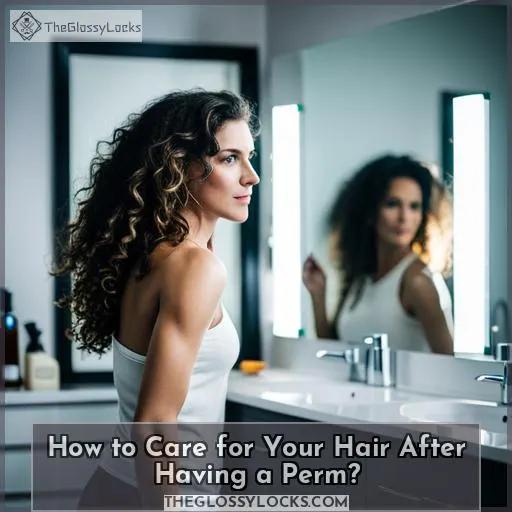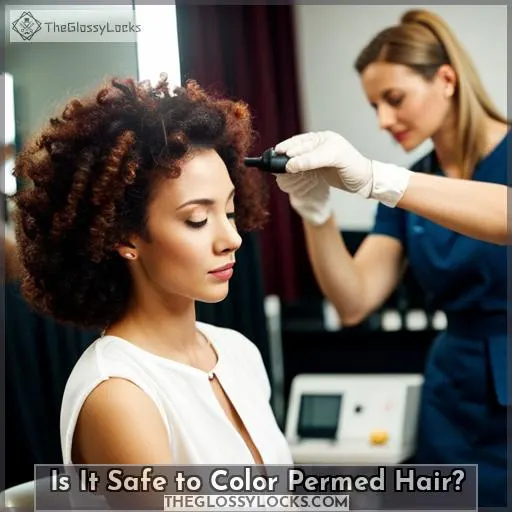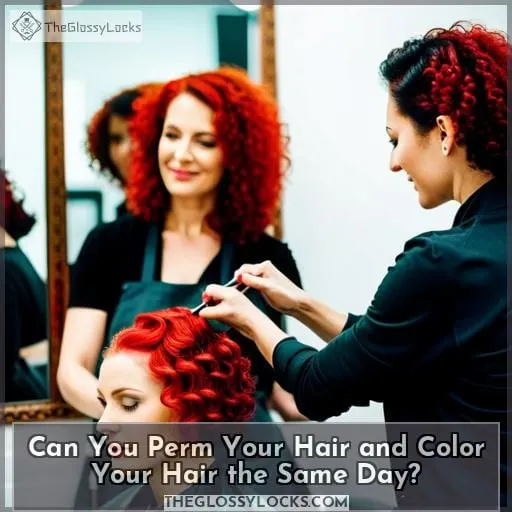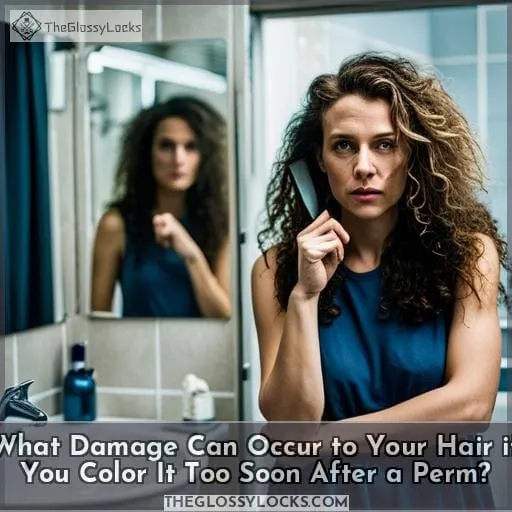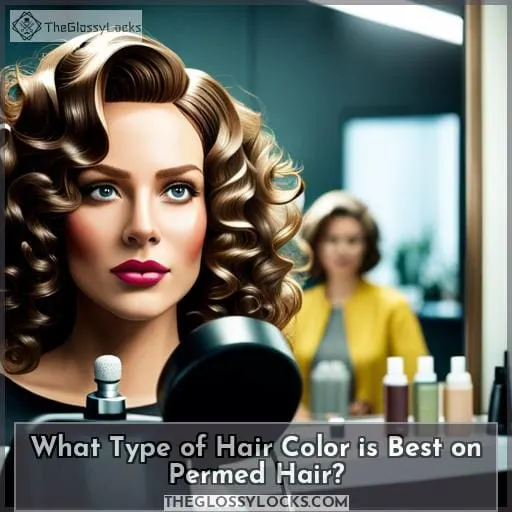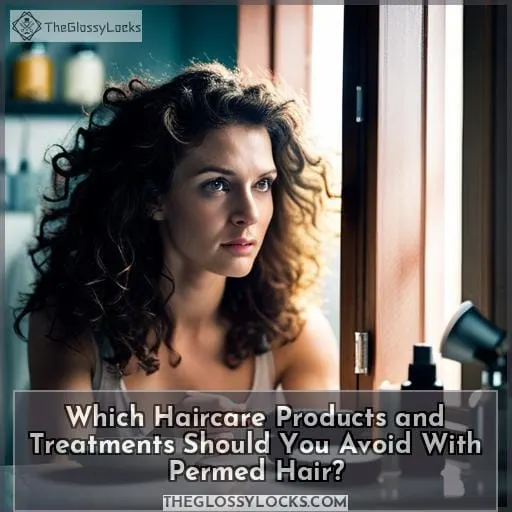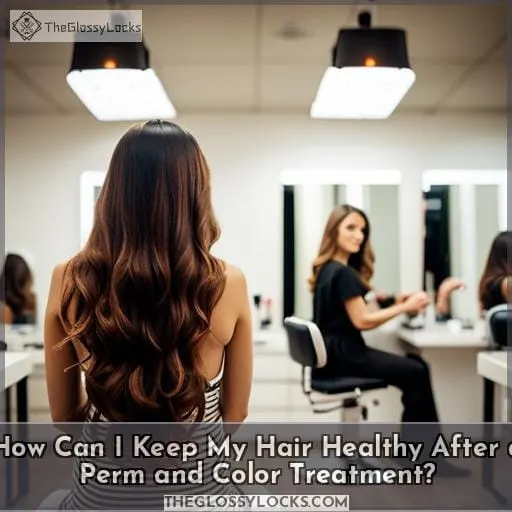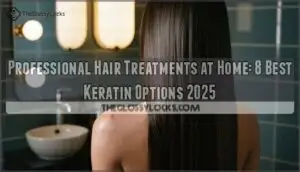This site is supported by our readers. We may earn a commission, at no cost to you, if you purchase through links.
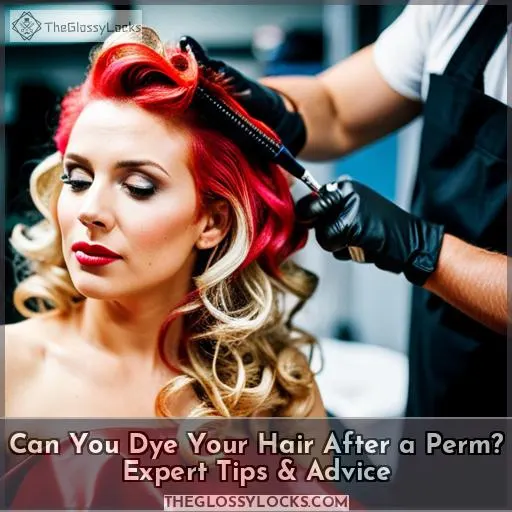 Are you wondering if you can dye your hair after a perm? It’s like walking on eggshells – one wrong move and the end result could be disastrous. To make sure that doesn’t happen, we have all the advice from experts to ensure you get the look that makes heads turn without damaging your hair.
Are you wondering if you can dye your hair after a perm? It’s like walking on eggshells – one wrong move and the end result could be disastrous. To make sure that doesn’t happen, we have all the advice from experts to ensure you get the look that makes heads turn without damaging your hair.
Perming is a chemical process which changes the structure of each strand by breaking down proteins using an alkaline solution.
Read on for answers to these questions as well as tips on how best to take care of colored-permed locks!
Table Of Contents
- Key Takeaways
- What Happens to the Hair During the Perming Process?
- Which Hair Types Are Best for Having a Perm?
- How Damaging is a Perm on Your Hair?
- How to Care for Your Hair After Having a Perm?
- Is It Safe to Color Permed Hair?
- Can You Perm Your Hair and Color Your Hair the Same Day?
- What Damage Can Occur to Your Hair if You Color It Too Soon After a Perm?
- What Type of Hair Color is Best on Permed Hair?
- Which Haircare Products and Treatments Should You Avoid With Permed Hair?
- How Can I Keep My Hair Healthy After a Perm and Color Treatment?
- Frequently Asked Questions (FAQs)
- Conclusion
Key Takeaways
- Wait at least two weeks before coloring permed hair.
- Use ammonia-free or low-ammonia dyes on permed hair.
- Avoid perming and coloring hair on the same day.
- Subtle highlights or soft balayage are the best options for coloring permed hair.
What Happens to the Hair During the Perming Process?
You’ll break and reconnect protein bonds to reshape your hair structure, then heat may be used to help form new curls – but coarse locks may not keep the style as long.
Perm chemicals like ammonium thioglycolate and sodium hydroxide are harsh on your hair, leaving it dry and brittle if you don’t take care of it.
To protect chemically treated strands from damage, use a mild shampoo for colored or permed tresses such as an ammonia-free formula that won’t strip away natural oils.
Nourish with nutrient-rich products containing shea butter or argan oil after treatments; deep condition regularly for full body curls without split ends.
Color wise, stick with subtle highlights or balayage instead of permanent dyes so you can enjoy beautiful beachy waves without risking further damage to already fragile strands – just wait at least two weeks before coloring after a perm!
Which Hair Types Are Best for Having a Perm?
Fine, straight hair is the best type for a perm as it’ll hold curls the longest and give you the most defined results. Coarse hair might not keep its curl shape for long, while thick strands may lack definition due to their volume.
Chemical treatments like perms can weaken your hair’s structure by breaking down protein bonds with harsh chemicals such as ammonium thioglycolate or sodium hydroxide.
Opting for natural oils such as argan oil or shea butter helps immensely in adding moisture back into chemically treated tresses. Avoid frequent combing/brushing, elastics, and clips to prevent breakage too! By doing this, you also maintain full-bodied curls, which is great if you’re looking to add some color afterwards.
Always seek out products specifically formulated for colored & chemically treated tresses. They help protect from further damage caused by heat styling tools used afterwards.
How Damaging is a Perm on Your Hair?
A perm can be quite damaging to your hair, so it’s important to take extra care afterwards. After a perm, the moisturizing effects of natural oils and deep conditioning are essential for maintaining chemical balance within the curls and ensuring long-lasting curl definition.
Heat protection products should also be used before styling with heat tools as they help protect permed hair from further damage.
Regular trims are also necessary to prevent split ends that could weaken or break off fragile strands, causing loss in curl definition over time.
When dyeing permed hair, it is best to wait at least two weeks after having a perm before applying color as chemicals such as ammonia or hydrogen peroxide found in dyes can cause additional damage on already chemically altered bonds of hairs which have been recently subjected to harsh chemicals during the process of getting a permanent wave treatment done.
It is always recommended that you see an experienced professional if you plan on doing any kind of chemical treatments like these since they know exactly what needs to be done safely without risking too much harm onto your tresses!
It’s important not only to use good quality products meant especially designed specially catered towards chemically treated hairs but moreover make sure you’re taking extra special care by avoiding frequent combing/brushing & elastics clips; limit use of heat tools; shampoo less often (opt rather for more frequent deep conditioners); add moisture with natural oils like argan oil & shea butter, etc.
All of this combined together will guarantee healthy-looking locks free from damages caused due to adverse effects resulting from negligent usage of various forms of harsh beauty treatments such as those involving the application of powerful chemicals involved in making drastic changes to one’s physical appearance through changing hairstyles dramatically via processes similar to subjecting them to permanent waves, etc.
How to Care for Your Hair After Having a Perm?
Caring for your chemically-treated hair is essential to long-lasting curls, so condition deeply and trim split ends regularly to keep locks looking full of life.
- Limit the use of heat tools.
- Use nutrient-rich products after chemical treatment for healthy hair.
- Apply a hot oil treatment twice monthly before shampooing and conditioning as normal.
- Avoid frequent combing/brushing, elastics, and clips, which can cause breakage due to extra tension on fragile strands.
Chemical treatments are harsh on your tresses – they weaken bonds in the cuticles, causing moisture loss when not cared for properly. But with proper curling techniques and regular protective care, you’ll be able to maintain beautiful results that last! Don’t forget to use ammonia-free shampoo specifically designed for chemically treated hair.
Opt out from permanent dyes if coloring. Apply a deep conditioner weekly along with occasional hot oil treatments, and get a trim once a month.
Is It Safe to Color Permed Hair?
It’s understandable to want to try out different hair colors, even after getting a perm. But with so many chemical processes already impacting your hair, you need to take special precautions when deciding if and how you should color it.
All bleaching effects – including from the sun – can cause damage or dryness in permed strands. To protect them as much as possible from additional chemical reactions, proper timing is key. Wait at least two weeks after having a perm before coloring your hair again for the best results and safety of your strands.
This will give them time to recover properly first before facing any more treatments.
When ready, use only safe products specifically designed for chemically-treated hair that are free of ammonia or resorcinol dyes, like semi-permanent dyes, which allow healthy locks while still creating fun looks! If applied correctly by professional stylists who understand perms well enough, they may be able to help create beautiful hues without excessive drying or breakage caused by styling techniques gone wrong!
Can You Perm Your Hair and Color Your Hair the Same Day?
No matter how tempting, coloring your hair the same day as perming is a bad idea. It’s like combining two powerful storms into one. Overdyeing risks causing serious damage to already fragile strands due to the harsh chemicals used during the perm process.
The combination of tight curls and color can lead to short-term effects such as dryness or breakage in some cases, so it’s best avoided altogether. Heat styling after a perm should be done with caution and use products that provide extra protection from heat for better results.
Using color-protecting shampoo will also help prevent fading when washing colored hair post-perm. Additionally, using an ammonia-free dye helps preserve the integrity of treated strands without drying them out further or disrupting the curl pattern too much.
To step out safely with vibrant color and bouncy curls, at least 10-15 days should pass before you even consider re-coloring your locks!
What Damage Can Occur to Your Hair if You Color It Too Soon After a Perm?
Coloring your hair too soon after a perm can weaken the curls or cause breakage due to extra tension on fragile strands. It’s best to wait at least two weeks before coloring, as the perming process uses harsh drying chemicals like ammonium thioglycolate and sodium hydroxide that make hair more susceptible to damage.
To prevent further harm, use an ammonia-free or low-ammonia dye with a color protectant shampoo. Opt for subtle highlights/lowlights instead of full coverage. Avoid at-home dyes, which may counteract desired results.
To keep your hair in its most healthy state, deep condition weekly and trim split ends regularly. Doing this will maintain full-bodied curls while protecting them from any additional damage caused by chemical treatments such as coloring.
What Type of Hair Color is Best on Permed Hair?
It’s important to understand the effects of chemical treatments on your hair if you’re considering coloring after a perm. If it’s been less than two weeks since you had the perm, be sure to wait before dyeing as this can weaken curls or cause breakage due to excess tension on fragile strands.
Select ammonia-free or low ammonia dyes, which will help preserve your permed hair integrity and avoid permanent colors. Subtle highlights, lowlights, and soft balayage are all great options for adding depth without disrupting the curl pattern, while blonde shades give a beachy look.
To ensure desired results, it’s best to see an experienced stylist who can evaluate how much time should pass between treatments in order for your hair not to suffer any damage from two chemical processes at once.
Root colors like chalk work well with perms as they don’t require harsh chemicals but rather add color through pigment binding that won’t affect curls.
| Dye Selection | Heat Styling |
|---|---|
| Ammonia/Low Ammonia FreeSubtle Highlights & LowlightsSoft BalayageBlonde Shades (Root) Hair Chalks1 | Limit use of blow dryers & other heat tools.Protects with products. |
Which Haircare Products and Treatments Should You Avoid With Permed Hair?
Avoid harsh tools and chemicals after perming your hair—they can damage curls or cause breakage. Use ammonia-free, resorcinol-free products and color to preserve the integrity of your locks.
Be wary of heat styling as it can be too much for chemically treated hair. Instead, opt for natural oils like argan oil or shea butter to add moisture without damaging strands.
Regularly trim split ends since chemically altered hair is more vulnerable to breakage than before the perm.
For coloring, stick with subtle highlights or lowlights that accentuate texture but don’t overwhelm it.
To ensure dye stays longer on permed strands, use color protecting shampoo. Additionally, deep condition regularly to prevent dryness from chemical relaxers, which further weakens already fragile hairs.
How Can I Keep My Hair Healthy After a Perm and Color Treatment?
To maintain healthy hair after a perm and color treatment, use a mild shampoo for chemically treated hair and add moisture with natural oils like argan or shea butter. Protect your permed locks from heat damage by using products that provide protection before styling.
Avoid coloring too frequently to prevent excessive damage, which can leave you with dull, lifeless tresses.
Here are some tips:
- Moisturize your strands twice weekly with natural oils such as Argan or Shea Butter.
- Use heat protection sprays when blow-drying or flat ironing.
- Limit chemical treatments such as relaxers and permanent coloring on your already processed hair.
- Wash your hair no more than 3 times per week in lukewarm water using only gentle shampoos specifically designed for colored treated/permed tresses. This will help preserve the vibrancy of the colors while still keeping it clean and soft.
Following these steps will ensure gorgeous-looking locks even after undergoing multiple chemical processes!
Frequently Asked Questions (FAQs)
How long do the effects of a perm last?
The effects of a perm last for 6-12 weeks, depending on the length of your hair. Take good care and treat your locks with nutrient-rich products to keep them healthy. Avoid overusing heat tools and elastics after chemical treatments to maintain strong curls or waves that will last longer.
What kind of products should I use to protect my hair after a perm?
After a perm, protect your hair with nutrient-rich products. Avoid blow dryers and heat tools. Use color-protecting shampoo, provided conditioner, and deep condition regularly to keep hair healthy.
Is it safe to perm and color my hair on the same day?
No, it is not safe to perm and color your hair on the same day. The chemicals used in both processes can cause significant damage if done together. Wait at least two weeks after perming before coloring for healthy, long-lasting results.
What type of dye should I use on my permed hair?
For best results with permed hair, use an ammonia-free or low-ammonia dye. Subtle highlights and balayage add depth while protecting the curl pattern.
How often should I deep condition my hair after a perm?
Deep condition your permed hair every week for luscious, healthy curls! Pamper those strands with nutrient-rich products to keep them bouncy and beautiful – it will be worth the effort when you’re rocking amazing-looking hair.
Conclusion
From fine, straight hair that shows off the perm the best, to thick hair that may lack curl definition, perming hair can be a great way to change up your look. However, it’s important to know what you’re getting into when it comes to the perming process and caring for your hair after.
It is possible to dye your hair after a perm, but you should wait at least two weeks before doing so. Using an ammonia-free or low ammonia dye is best to preserve the integrity of your permed hair. It’s also important to use mild shampoo and natural oils to keep your hair moisturized and healthy.
With the right care and knowledge, you can enjoy a beautiful perm and hair color that will last.

